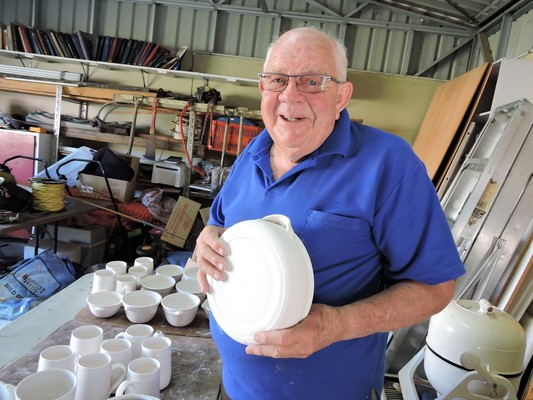By Jeremy Sollars
A conversation with Warwick potter RAY TAINTON, Warwick Potters Association patron …
When you walk into Ray’s shed you are greeted by a silky moppet (dog) named Piper, a galah squawks nearby; the shed is adorned with pottery, some fired and some not, a pottery wheel, books, fishing rods and a life-sized poster of Lawrence Springborg looking down from high up in the rafters.
Ray warmly welcomes me, and we take a tour through his studio and his life.
Born into a family of teachers, it wasn’t hard for Ray to find his career path in education, but a career in pottery caught him by surprise.
When did you realise you had a talent for pottery?
As a Year 7 staff teacher of 45 children at Wulguru 1968, the ‘boss’ told me to find something to do in art with the $10 half year art fund. He suggested why not pottery and I thought at the time, “Oh no, not pottery”.
I went to the Stuart Cement Works in Townsville and got a bag of dried out clay and wet it down in a barrel. Some days it was soft, some days it was hard, some days just right and we made a few things by hand. The kids wanted to fire them, so we built a ‘Kelvin Grove’ Raku kiln from a design sent by teachers college. I had caught the pottery bug.
Hand building for six years, as I couldn’t afford a wheel but made one out of a slab of concrete and a self-centred bearing on top – you would kick the concrete and it would spin for 11minutes. I went automatic – nearly – with the addition of a washing machine motor on the side with a spring loaded motor mower wheel to drive the concrete slab. I learnt to throw pots very fast because of that wheel. I won an award for throwing 27 bowls in 20 minutes in 1982.
My firings were improved by trial and error. My first fuel firing I melted the silica and the pots to bottom of the kiln – no meters, no codes, ‘Oh yes, nearly hot enough’ was the gauge. Did not know much about glazes, but over time I found my own glazes that are a feature of my work. I started giving classes in 1972.
Is art still as important in schools as it once was? There has been a downturn of interest in the arts, not helped by the cancellation of pottery as a course in Year 11 and 12. No art or pottery at TAFE today where I was the Warwick co-ordinator for adult education.
What benefit is pottery to the individual?
It gives you an outlet to mix with other creative people and talk about the subject in common. I could take my family for a weekend seminar at Hervey Bay for example and we would all have a great weekend. You find a party happens if you start firing a kiln.
How do you encourage young people to start pottery?
Well they need to turn up and start potting. Have a go and you learn something from each tutor you go to. You can take away something with pottery. The Warwick Potters Association offer beginner and advanced classes and workshops.
What do you think of Jumpers and Jazz in July and the changes of late?
JJJ advertises the pottery club through our Hot Pots Soup Night and Picnic In the Park Craft Market, it encourages new members and gives us funds to continue to operate the club.
Do you think it can continue with just volunteers?
It will continue with volunteers, but it needs someone up the top. If you didn’t have a person to lead and make those decisions for the greater good of the whole event, it will be difficult.
What are you working on at present in pottery?
I’ve done exhibition pieces, but it is the practical things such as cups that people want. I have to fill an order before Anzac Day which only just came in, and I have a continuous stream of orders for bowls and coffee cups.







